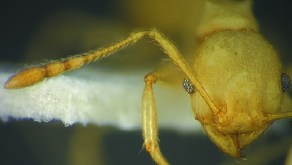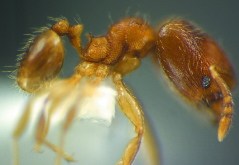Formal retirement hasn't slowed E. O. Wilson down at all. Since assuming emeritus status as Pellegrino University Research Professor in 1997, Wilson—the father of sociobiology and biophilia, the most acute student of ants among contemporary scholars, perhaps the foremost scientific spokesman for the importance of biodiversity—has, if anything, stepped up the pace of his research and writing and of his advocacy for conservation, toward which his science has impelled him.
Last year, he published The Future of Life, the most accessible and impassioned of his appeals to humans to take heed of the millions of other species that make the planet habitable. This March, Harvard University Press delivers Pheidole in the New World, Wilson's enormous monograph on the "hyperdiverse" ant genus he has scrutinized for decades. The latter work is, first, a labor of love: Wilson took 16 years to complete it as an after-hours "hobby" at home, drawing all 5,000-plus illustrations himself. In scholarly terms, it bridges the established science of biological systematics and its emerging future: a CD accompanies the printed book, and work underway at the Museum of Comparative Zoology and elsewhere assures that such painstaking research will henceforth be refined and accelerated using digital imaging and genomics techniques, and then promptly disseminated to users worldwide by the Internet. Further, the finished book makes a compelling case in Wilson's larger argument about the dazzling, barely understood, complexity of life: of the 624 known Pheidole species in the Western Hemisphere described here, he says, 337 are new to science.
"Destroying Part of the Creation"
Wilson's life's work, it has become increasingly clear, is fueled by passions intellectual, practical, and aesthetic. Those elements, combined, have driven him to span the extreme ranges of a spectrum from the popularizing synthesist and policy advocate to the microscopically detailed specialist. But such seemingly disparate works spring from a common source—what one might call his dismay about ignorance and its consequences.
The starting point, Wilson recently wrote, is "our present meager knowledge of the biosphere and the species composing it." He estimates that humans have named 1.5 million to 1.8 million species—yet only one percent have been studied in any detail beyond some characterization of habitat preference and anatomical features. Further, scientific estimates of the total species populating the planet range from 3.6 million to 112 million. Most, it is true, may be microscopic bacteria, fungi, and nematodes (all biologically important in unknown ways). But even the number of such comprehensively categorized organisms as flowering plants swells by some 2,000 new entries in the standard reference annually. Never mind the laity: biologists themselves, writes their colleague, "appear not to fully appreciate how thin the ice is on which they skate."
This last image begins to suggest why existing in a world "where most of biodiversity is still entirely unknown" poses challenges beyond the merely intellectual. As Wilson writes in The Future of Life, "Earth, unlike the other solar planets, is not in physical equilibrium. It depends on its living shell to create the special conditions on which life is sustainable"—an endowment of soil, water, and atmosphere, evolved over eons, about whose creation and maintenance humans remain largely clueless.
 |
 |
P. horribilis |
Photographs by Sarah Ashworth. Drawings by E.O. Wilson. Reproduced from the book, "Pheidole in the New World" and its accompanying CD. |
In a steady-state, Edenic world, such ignorance could be bliss. But Earth, peopled by people, is nothing like that. A decade ago, Wilson wrote in Science that one-fifth or more of all species might vanish within 30 years. He upholds that estimate, and has updated it to project that as many as half of the planet's life forms could disappear during the twenty-first century under the joint assaults of habitat destruction, invasive species, pollution, population pressure from humans, and overharvesting. Beginning with "our not really understanding with any degree of knowledge what is in an ecosystem," he says, humans are in the disquieting position of finding that "we cannot assess the consequences of change through pollution or climate warming" for even simple habitats like a lake or marsh. The stakes are much higher in areas with species-rich tropical forests and coral reefs—the very venues where the fastest-growing and most desperate human populations live today, often barely surviving by mining, and obliterating, the nearby fruits of nature, never mind the consequences for tomorrow.
If such concerns seem too remote or abstract for denizens of the rich, industrialized world, Wilson offers a third appeal. Life, he believes, is smitten with life—the instinctual phenomenon he calls "biophilia." "Each species is a masterpiece of evolution," he wrote in Time in 1995, and so at some level humans recognize that extinguishing a species is "destroying part of the Creation." In an interview at his happily cluttered office in the Museum of Comparative Zoology (MCZ) laboratory building—near a bustling colony of Pheidole rhea ants awaiting study and sharing the fruit scraps from lunch—Wilson explains "the sheer pleasure that comes of knowing individual species and being in a rich ecosystem." Illustrating what is at risk, he suggests that anyone who loves orchestral music might imagine the aesthetic experience if all the woodwind instruments were withdrawn from the stage during a performance, and then the horns, and so on until only a bassoon remained, and finally it, too, fell silent.
"Completing the Linnaean Enterprise"
How, then, to proceed? For Wilson, coming to terms with Earth's biology begins with an urgent effort to "complete the great Linnaean enterprise." Since Carolus Linnaeus, the Swedish botanist, began establishing the nomenclature for systematic classification of life forms in the 1730s, it has taken a quarter-millennium, "using methods developed in the eighteenth and early nineteenth centuries," Wilson says, "to cover what is likely to be somewhat on the order of 10 percent of the species of organisms." This estimate—using a guess for the likeliest number of flora and fauna incognita—forms the prelude to a related, more audacious leap of faith: "We can likely do almost all of the rest of the 90 percent in the next 25 years."
This would seem a preposterous claim, in light of the 16 years Wilson has just devoted to filling out his corner of the Pheidole, a relatively recognized and readily observed group. That feat was a classic example of the way the world's 6,000 or so taxonomists proceed: shipping type specimens (one of Wilson's ants dated from 1826) from distant repositories to the scholar who is studying them; performing meticulous physical examinations in a laboratory setting; and handcrafting descriptions.
 |
P. gilva |
 |
P. spaerica |
But Wilson, in fact, is quite happy to characterize his Herculean encounter with the ants as "the last of the great sailing ships." During the years that the Pheidole monograph took shape, he says, "new technologies have pretty much come together, almost suddenly." In the laboratory of his organismic and evolutionary biology colleague Brian D. Farrell, professor of biology, software-enhanced digital photography captures stunningly detailed images of minute insect specimens—"better than what can be seen with the eye through optical microscopy," says Wilson. Drawing on Harvard's enormous collections of insect type specimens, collected over generations, whole libraries of such images can be assembled for instant high-resolution comparison with similar species.* A researcher with an Internet connection, working in the field, can reduce the time it used to take to identify specimens from months to, literally, minutes. Of his Pheidole research and the collaborators who shipped him samples from collections throughout the United States, Latin America, and Europe, Wilson says, "With the new technology, I probably could have done it single-handedly in a few months," with no sacrifice in scholarly rigor, detail, or accuracy.
And what of the creatures smaller and more numerous still—the untold thousands of unknown bacteria, the perhaps million or more unrecognized fungi? Here, Wilson believes, genomic techniques will come into play, helping scientists distinguish species' evolution, traits, and functional attributes.
In combination, these technologies can transform the "little science"—systematics the Linnaean way, teasing out floral and faunal taxonomy—whose halting progress concerned Wilson a decade ago, into a high-productivity, fast-output enterprise. His grail is to see this "bigger science," properly directed and funded, scaled up so that the work that went into Pheidole can be vastly accelerated, yielding a comprehensive "encyclopedia of life" within the next quarter-century. As the enterprise gathers momentum and unit costs decline, Wilson envisions identifying, say, 10 million new species at $500 apiece—an investment of $5 billion over the next couple of decades. His favorite analogy, in scope, speed, and cost, is the recent Human Genome Project, which sequenced the genetic code of Homo sapiens.
Can this really work? The New York Botanical Garden has already digitized its nearly 90,000 type specimens of vascular plants, and other collecting centers are building comparable databases. Farrell—whose tiny passion is bark beetles, not ants—is in the Dominican Republic this year, working with students in prototype field laboratories to make a comprehensive inventory of the island's insect and other animal species. Wilson himself serves on the scientific board of the ALL Species Foundation (a nonprofit organization created in 2000, www.all-species.org, "dedicated to the complete inventory of all species of life on Earth within the next 25 years"), a clearinghouse for digital species databases and a research center for Internet technologies that will be used to compile, update, and ease the use of such libraries. With that foundation, he convened a meeting at Harvard in October 2001 of like-minded scientists and representatives of organizations from around the world to discuss, and advance, the encyclopedia project. At last count, the foundation had indexed 874,000 species through a dozen cooperating databases, ranging from AmphibiaWeb through the World Spider Catalog.
"A Surgeon Cutting an Artery"
Of course, accelerated efforts to identify species will count for little if humankind exterminates them far faster than they can be recognized. So along with filling in the entries in life's encyclopedia, Wilson also proselytizes for much-enhanced conservation biology—a science he has recently, grimly, described as "a discipline with a deadline" and the "intensive-care ward of ecology."
The positive case for the field is the complex problem of understanding how biological communities are assembled and function. Far from the image of the lonely field biologist in mud boots collecting specimens, this larger challenge surely requires "megascience" on the scale of solving the riddles of particle physics or cosmology. The practical case—that "thin ice" he referred to—is driven by a race between ignorance of living systems in a dynamic world, and the specter of overwhelming loss of habitats and their species in almost no time.
 |
 |
P. astur |
Wilson's early study of islands established that biodiversity in a habitat—the sheer number of species it sustains—increases with size. He says that modern ecological experiments, in test plots and synthetic greenhouse environments, demonstrate that "as you pull species out, especially plants, production drops for the whole system."
Together, those findings mean that small habitats—or habitats made smaller by logging, say, or clearing for cultivation—are populated by fewer species, reducing the living system's redundancy, its ability to withstand stresses such as drought or fire, and its sheer cycling of biological matter. In a system rich with nearly equivalent species, Wilson says, their overlap is insurance against the loss of some critical biological function in case of a local extinction: "When you start pulling species out, if you have a very diverse system, you won't get serious perturbation. But if you pull out quite a few, you'll lose stability and production." In smaller and diminishing habitats, resilience declines. A 90 percent reduction in the size of a habitat, he observes, causes the loss of 50 percent of its species and leaves the remaining life forms "extremely vulnerable." "Edge effects" heighten the risk as, say, a tropical forest is suddenly bordered by barren cropland, exposing its margins to intense and drying sunlight, destructive winds, and fire.
In the worst instances, Wilson says, "You might, accidentally, get the effect of a surgeon cutting an artery." This extreme, the loss of a "keystone species," causes wholesale collapse. From his 1992 book, The Diversity of Life, Wilson cites the over-hunting of sea otters, which allowed the population of sea urchins to explode, unleashing a rampant consumption of kelp that caused the denuding of "kelp forests" and the myriad species they sheltered—a form of underwater clearcutting that converted a diverse habitat to "sea-urchin barrens." Of course, in the current state of ignorance about species and ecosystems, he emphasizes, "We don't know which species are key" until after the fact.
Focusing only on the species implications of habitat conservation minimizes the other, real, benefits man and nature derive— and depend on. Among those "opportunity costs" endangered by habitat destruction, Wilson enumerates scientific knowledge; potential pharmaceuticals (evolution has equipped plants and animals with valuable chemical tools to defend themselves from assault, a phenomenon already well represented in human medicine cabinets); and such unacknowledged services as "functioning as a watershed, retaining soil, producing new soil," and so on.
 |
 |
P. terribilis |
The conservation biologists' chief concern is the disappearance of old-growth woodlands, primarily in the tropics but also in fragments along the Pacific Rim and elsewhere. During the second half of the twentieth century, Wilson notes, the world reservoir of such forests decreased by one-third, from 50 million square kilometers to 34 million. In and around Amazonia, some of those species-rich woodlands are falling to flame and ax at the rate of 1 percent to 2 percent per year.
So Wilson the educator evangelizes—in The Future of Life, in countless speeches and articles, in consultations with the editors of National Geographic and the executives of the Organization for Economic Cooperation and Development, and through organizations such as Conservation International and the Nature Conservancy, on whose boards he serves—for the urgent protection of 25 world "hot spots," at the minimum. These tracts of tropical rainforest, savanna, and coastal sagebrush, considered both especially rich in species and especially endangered by human encroachment, total only 1.4 percent of Earth's land surface (about the equivalent of Texas plus Alaska). They are, he writes, "the exclusive homes of 44 percent of the world's plant species and more than a third of all species of birds, mammals, reptiles and amphibians. Almost all are also under heavy assault." He urgently advocates that they be acquired for natural preservation, at a cost of $25 billion or so. The funds could readily be secured, he believes, from existing private and government conservation investments, and by ending subsidies that make it cheaper to exploit natural resources than to reuse materials or promote silviculture.
 |
P. cardiella |
 |
P. psilogaster |
Wilson also advocates other policies that could protect habitats: ceasing the logging of old-growth forests worldwide; protecting marine habitats, especially coral reefs—the aquatic equivalent, in diversity and endangerment, of tropical rainforests; promoting every opportunity to make conservation profitable, especially for the people who live next to or in nominally protected parks or biologically rich hot spots in the world's poorer nations; and promoting population control. But he gives highest priority to the hot-spot strategy, not only because of the resources at stake but also because of its inherent appeal. Wilson cites the recent $261-million gift to Conservation International by Intel cofounder Gordon Moore—to support hot-spot acquisition and biological monitoring and training stations throughout the world—as a tangible demonstration that this life-raft strategy has a real chance to succeed. Both men are directors of Conservation International, where Moore chairs the board; Wilson says he was "among those, as a member of the board, who helped stimulate and advise" Moore on his conservation philanthropy.
"A Magellenic Voyage around a
Tree Stump"
Spokesman and popularizer though he may be, Wilson remains above all a scientist enraptured by the mysteries of life. The Pheidole project, he says, represents a "celebration" of this most abundant group of ants. Cataloging them comprehensively, he says, was a step toward unraveling the unsolved problem of why some species are "so profusely evolved"; the work itself was "the taxonomist's equivalent of figuring out the hemoglobin molecule." Lest graduate students fear there are no more such challenges, Wilson is ready with dozens. Bacteria and archaeans, he writes, are "the black hole of biological systematics." Only about 6,000 have been formally recognized—despite the potential threat and benefit they represent to human health and commerce—but that many, "almost all new to science, can be found in only a few grams of rich forest soil." Nematode worms, he says, account for four of every five animals living on Earth—and are so abundant that if the planet's surface vanished, its "ghostly outline" could still be made out in the biomass of nematodes, almost all of species unknown.
 |
 |
P. zelata |
Recalling that he has been "enthralled from childhood" by nature and living things, Wilson says a lifetime of scientific study has made him "more and more impressed and attracted by the complexity in a single ecosystem." That such complexity extends to the level of genetic code makes the challenge ever more compelling and beautiful. "There is no end to science!" he exults—nor to the "sense of joy" involved in probing the endless frontier of life's complexity. In fact, he promises, "You could spend a lifetime in a Magellenic voyage around a single tree stump" without ever coming to the end of discovery.






